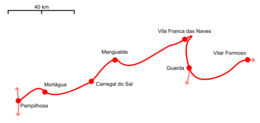
CP — Comboios de Portugal, EPE is a state-owned company which operates passenger trains in Portugal. Prior to June 2009, CP stood for Caminhos de Ferro Portugueses although the company has been using its current designation as a brand name since 2004.
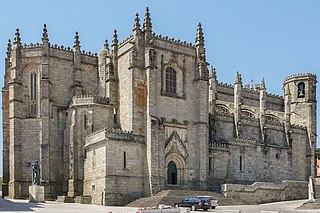
Guarda is a city and a municipality in the District of Guarda and the capital of the Beiras e Serra da Estrela sub-region in central Portugal. The population in 2021 was 40,126, in an area of 712.10 square kilometres (274.94 sq mi) with 31,224 inhabitants in the city proper in 2006. Founded by King Sancho I in 1199, Guarda is the city located at the highest altitude in Portugal and one of the most important cities in the Portuguese region of Beira Alta. Serra da Estrela, the highest mountain range in continental Portugal, is partially located in the district. The city is served by national and international trains on the Beira Alta and Baixa railway lines. The present mayor is Sérgio Costa, as an independent. The municipal holiday is November 27.
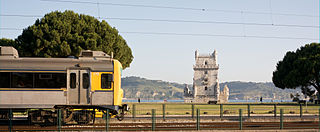
The Cascais Line is a Portuguese railway line which connects the municipalities of Lisbon, Oeiras, and Cascais. The line starts in Lisbon, at Cais do Sodré and ends in Cascais. The first section, from Cascais to Pedrouços, was opened in 1889. The line was completed in 1895. It was the first heavy rail line to be electrified in Portugal, in 1926, and the last to be integrated into CP, in 1977. In July, 2020, CP announced that the line is slated to be converted from 1500 V DC electrification, to 25 kV AC, to match the rest of the network. Signalling will also be upgraded and new trains acquired.

Linha da Beira Baixa, originally called Caminho de Ferro da Beira Baixa, is a railway line which connects the stations of Entroncamento and Guarda in central Portugal. The first section, from Abrantes to Covilhã was opened on 6 September 1891. The line to Guarda was opened on 11 May 1893. At the time, only the section from Abrantes to Guarda was considered to be part of Linha da Beira Baixa, while the route from Entroncamento to Abrantes belonged to the Linha do Leste. Passenger service on the Guarda-Covilhã segment reopened on 2 May 2021 after it fell into disuse in 2009.
Infraestruturas de Portugal, S.A. (IP) is a state-owned company which resulted from the merger of Rede Ferroviária Nacional (REFER) and Estradas de Portugal (EP). It manages the Portuguese rail and road infrastructure.
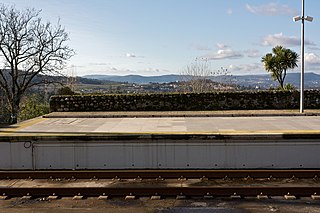
Ramal de Braga is a branch line in Portugal, which connects Nine railway station on the Linha do Minho, with Braga. It was opened on 21 May 1875. and modernised in 2004.
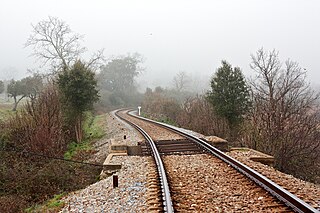
Ramal de Cáceres is a closed Portuguese railway line which connected Torre das Vargens railway station, on the Linha do Leste, and Marvão-Beirã railway station, near to the border with Spain. It was completed on 15 October 1879, but was only opened on 6 June 1880. From 1881, the line was used as a faster alternative for international travelers between Portugal and Spain compared to the Linha do Leste, due to a better connection to the Spanish network. It was closed by REFER on 15 August 2012.

Ramal da Figueira da Foz, also known as Ramal de Pampilhosa, and originally as Linha da Beira Alta, together with the section from Pampilhosa to Vilar Formoso, is a closed railway line in Portugal. It connected the stations of Figueira da Foz to the station of Pampilhosa, at the junction of Linha do Norte and Linha da Beira Alta, with a total length 50.4 km. It was opened on 3 August 1882, and closed on 5 January 2009, for safety reasons.

Linha de Leixões, also known as Linha de Cintura do Porto, is a freight railway line which connects Contumil railway station, on the Linha do Minho, and Leixões, in Matosinhos, Portugal. It was opened in 1938, and electrified in 1998. Passenger services ran until 1987 and from 2009 to 2011.

Ramal da Lousã is a railway line which connects the stations of Coimbra-B, on the Linha do Norte, and Coimbra, in Portugal. It was opened by the Companhia Real dos Caminhos de Ferro Portugueses, under the name Ramal de Coimbra, on 18 October 1885, and was extended to Lousã on 16 December 1906, and to Serpins on 10 August 1930.

Linha de Sines is a railway line which connects the station of Ermidas-Sado, on the Linha do Sul, to the Port of Sines, in Portugal. It used to be connected to the station of Sines via a branch line. The first section, from Ermidas-Sado to São Bartolomeu da Serra was opened on 9 April 1927. The line reached Cumeadas on 1 July 1929, Santiago do Cacém on 20 June 1934, and Sines on 14 September 1936.

Linha de Sintra is a railway line which connects the stations of Rossio and Sintra, Portugal. It is operated by Comboios de Portugal.
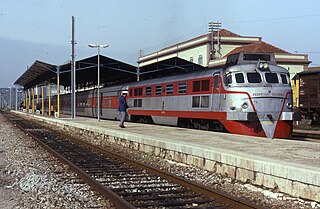
Abrantes Station is a railway station in Abrantes, Santarém, Portugal.
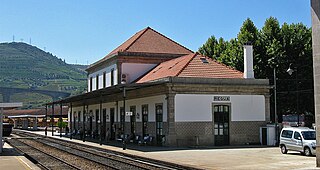
The Régua railway station previously known as Regoa railway station, is a station on the Douro Line, which serves the town of Peso da Régua, in the District of Vila Real, in Portugal. It opened in 1879, and served as a junction point with the Corgo Line, which operated between 1906 and 2009.

The Pocinho railway station is an interface of the Douro line, which serves the town of Pocinho, in the municipality of Vila Nova de Foz Coa, in northern Portugal. It also served as a junction with the Sabor line during its operation between 1911 and 1988. Since 1988 it has been the terminus of the Douro Line, given the closure of the section that extended to Barca d'Alva and Spain.

The Barca d'Alva railway station was the terminal interface of the Douro Line, until the station's closure in 1988, which used to serve Barca d'Alva and acted as a border station between Portugal and Spain, via the Barca d'Alva–La Fuente de San Esteban railway. It is located in the municipality of Figueira de Castelo Rodrigo, in Portugal.
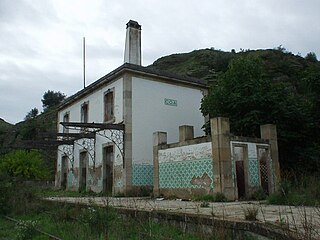
The Coa halt, is a closed interface of the Douro line, which used to serve the town of Vila Nova de Foz Côa, in the Guarda District, in Portugal. The halt started operating on 5 May 1887, and was closed in 2 October 1988.

The Mirandela railway station, was a station on the Tua line, which served the town of Mirandela, in the Bragança District of Portugal.

The Portuguese Railway Company was the main railway operator in Portugal. Founded on 11 May 1860 by the Spanish businessman José de Salamanca y Mayol under the name Companhia Real dos Caminhos de Ferro Portugueses, it changed its name after the 5 October 1910 Revolution. In the first half of the 20th century, it underwent a process of expansion, assimilating several private railway companies and the railways that had been under the management of the Portuguese government. However, the effects of the Second World War, and the advance of road and air transport its economic situation deteriorated to such an extent that, after the Carnation revolution, the company had to be nationalised and transformed into a new institution, called Caminhos de Ferro Portugueses.

The Maiorca halt was a railway halt of the shut down Ramal da Figueira da Foz, which served the town of Maiorca, Coimbra, Portugal, and closed in 2009.

